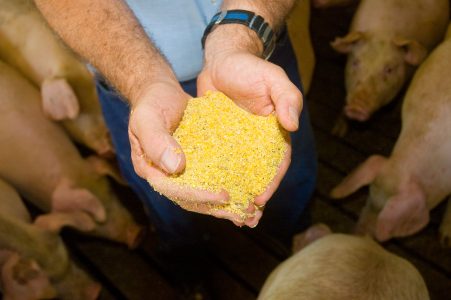New research is reshaping how swine producers view soybean meal (sbm). David Rosero, Assistant Professor at Iowa State University, shared findings that challenge long-held assumptions about feed energy, health benefits, and profitability.
He made his presentation at the Soy Connext 2025, organized by the US Soybean Export Council (USSEC). The event, which ran from August 20-22 in Washington DC, was attended by over 700 participants from around the world.
Dr Rosero began by asking a simple but important question: Are all calories equal in swine production? His answer pointed to the “soy effect”—a concept built on four key pillars that make US sbm a strategic tool for swine producers.
Sbm delivers more energy than expected
Recent studies show that sbm provides more usable energy than older models predicted. In commercial farms, US sbm can offer 82-125% of the energy value of corn. This is higher than the 77% estimate from NRC 2012 guidelines.
Energy values vary based on:
- ➡️ pig genetics
- ➡️ diet formulation
- ➡️ farm conditions
Higher crude protein in sbm also increases in energy value. Thus, nutritionists should consider both protein and energy when formulating diets. This supports better feed efficiency and growth, even when pigs face heat stress or disease.
Functional bioactive benefits
Sbm contains bioactive compounds that go beyond basic nutrition. These include:
- ➡️ polyphenols
- ➡️ terpenoids
- ➡️ oligosaccharides
- ➡️ fiber
These elements may reduce the energy pigs need for basic survival. This frees up more energy for growth. They represent approximately 70% of all functional compounds is sbm.
They also have systemic antiviral and antimicrobial effects, may help pigs recover faster from infections like PRRS.
Maintaining growth in hot weather
Summer heat often reduces pig weight and carcass quality. Dr Rosero presented a summer diet strategy using sbm. This approach avoids added fat and DDGS, and instead uses minimum sbm levels by phase.
Results from commercial farms showed:
- ➡️ higher final weights (up to 2.7kg more)
- ➡️ heavier carcasses (up to 2.1kg more)
- ➡️ fewer underweight pigs
- ➡️ lower feed costs (about USD 4 less per pig)
- ➡️ higher revenue per pig
This strategy helps producers maintain consistency and profitability during hot months, when market prices are often highest.
Superior protein source for late finishing
Removing or replacing sbm with DDGS or synthetic amino acids in late-finisher diets reduced pig performance. Pigs gained less weight and had lower final body weights.
This suggests that sbm offers benefits beyond basic nutrition. Its dense amino acid profile is critical for peak growth near market time.
Among the key findings:
- ➡️ DDGS reduced weight by almost 1.4kg
- ➡️ Crystalline amino acids reduced weight by 2.7kg
- ➡️ Average daily gain was lower in the late finishing phases.
Sbm: A strategic tool
In summary, Dr Rosero highlighted four key roles of sbm:
- ➡️ It provides more energy than previously thought
- ➡️ It supports immune function and reduces stress
- ➡️ It improves growth during hot weather
- ➡️ It outperforms DDGS and synthetic amino acids in late finishing diets
These insights can help producers make better feed decision. They also show how sbm can improve both pig health and farm profitability.
“Soybean meal is not just feed, it is a strategic tool,” Dr Rosero noted.
His research should encourage swine producers and nutritionists to rethink how they use sbm in modern production systems.

